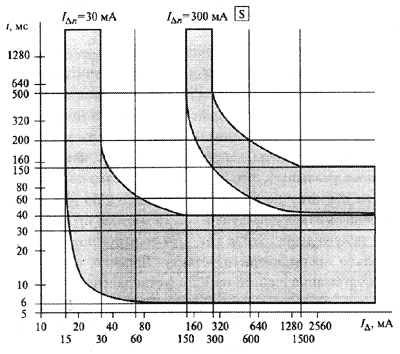Selectivity of RCD operation
To ensure the requirements for selective operation of several RCDs in radial power circuits, the following factors must be taken into account.
Due to the very high speed of the RCD, it is practically impossible to ensure the selective action of the RCD with respect to the current at the settings at the neighboring protection stages, for example, 10 and 30 mA, or 30 and 100 mA. It must also be taken into account that in practice the current leakage in the electrical installation does not necessarily increase smoothly as the insulation becomes aged, small defects appear, etc. Insulation breakdown or serious damage is possible when the leakage current instantaneously reaches a value significantly higher than the set point. It is logical that in these cases any of the RCDs installed in series in the circuit can be triggered.
The selectivity of the RCD can be ensured by the use of RCD modifications with a delay of the tripping time (RCD with indices S or G).
RCDs with index S have a time delay of 0.13 to 0.5 s (for a nominal differential current, see Table 4.3), with an index G, a slower shutter speed.
It is important to take into account that RCDs working with time delay are for a longer time under the influence of extreme currents, therefore they are subject to increased requirements for short-circuit (I nc ), thermal and dynamic resistance, switching capacity, etc.
In Fig. 11.1 shows the time characteristics of the RCD without time delay with a rated breaking differential current I D n = 30 mA and a time-delay RCD (characteristic S) with a rated breaking differential current I D n = 300 mA.

Figure 11.1. Time-current characteristics of the RCD

Figure 11.2. Examples of schemes with 2 and 3 selectivity levels
The practice of applying RCD with time delay is widespread in France to provide protection against fires. At the main input in the switchboard electrical installations, as a rule, install fire extinguishing type S with a nominal breaking differential current of 300 or 500 mA.
In Germany and Austria, time-delayed devices are applied to a lesser degree, preference is given to radial circuits with more sensitive RCDs that perform both electrical and fire protection functions.


Comments
When commenting on, remember that the content and tone of your message can hurt the feelings of real people, show respect and tolerance to your interlocutors even if you do not share their opinion, your behavior in the conditions of freedom of expression and anonymity provided by the Internet, changes Not only virtual, but also the real world. All comments are hidden from the index, spam is controlled.